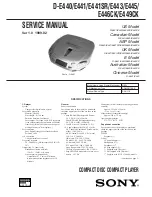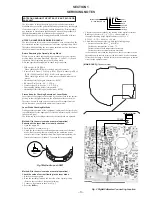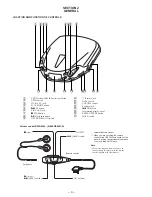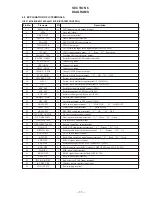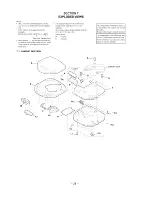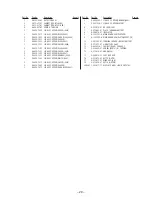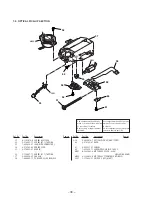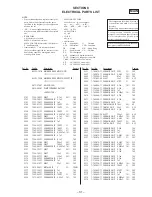
– 9 –
1. Place the optical pick-up level, horizontally. (If the optical pick-
up is not level, the 2-axis device will be weighted and adjust-
ment cannot be done.)
2. Connect the oscilloscope between IC501
0
pin (TEO) and
#º
pin (VC) on the MAIN board.
3. Set the disc (YEDS-18) and Press the
^
(
+
) key.
4. Turn RV502 slightly clockwise (tracking gain drops) and obtain
a waveform with a fundamental wave (waveform has large
waves) as in Figure 1 .
5. Turn RV502 slowly counterclockwise (tracking gain rises) until
the fundamental wave disappears (no large waves) as in Figure
2.
6. Set RV502 to the position about 30 °counterclockwise from the
position obtained in step 5. If RV502 contact point is more than
90 ° counterclockwise from mechanical center, tracking gain is
too high. In this case, readjust from step 4.
7. Press
^
(
+
) or
=
keys and observe the 100 track jump
waveform. Check that no traverse waveform appears for both
^
(
+
) or
=
directions. (See Figures 3 and 4.) It is ac-
ceptable if the traverse waveform appears only now and then,
but if it appears constantly raise tracking gain slightly and check
step 7 again.
8. Check that there is no abnormal amount of operation noise (white
noise) from the 2-axis device. If there is, tracking gain is too
high, readjust starting with step 4.
The waveforms are those measured with the oscilloscope set as
shown below.
• VOLT/DIV : 50mV
• TIME/DIV : 5mS
• Waveform when tracking gain lowered.
Fundamental wave appears (large waves).
Fig. 1
• Waveform when fundamental wave disappears (no large waves).
Fig. 2
• Waveform when no traverse waveform during 100 track jump.
(Brake application is smooth because of adjustment.)
Fig. 3
• Waveform when no traverse waveform during 100 track jump.
(Brake application is poor because of adjustment.)
Fig. 4
0V
0V
0V
100 track jump waveform
0V
100 track jump
waveform
traverse waveform
Focus/Tracking Gain Adjustment
A servo analyzer is necessary in order to perform this adjustment
exactly.
However, this gain has a margin, so even if it is slightly off, there
is no problem. Therefore, do not perform this adjustment.
Focus/tracking gain determines the pick-up follow-up relative to
mechanical noise and mechanical shock when the 2-axis device
operate. However, as these reciprocate, the adjustment is at the point
where both are satisfied.
• When gain is raised, the noise when 2-axis device operates in-
creases.
• When gain is lowered, it is more susceptible to mechanical shock
and skipping occurs more easily.
This adjustment has to be performed upon replacing any of the fol-
lowing parts :
• Optical pick-up
• RV503 (Focus gain)
• RV502 (Tracking gain)
Normally, be sure not to move RV503 (focus gain) and RV502
(tracking gain).
– Focus Gain Adjustment –
Procedure :
This adjustment is not performed. If focus gain RV503 is turned,
set to mechanical center
– Tracking Gain Adjustment –
(perform at normal operation)
[MAIN BOARD] (Side B)
10
oscilloscope
(DC range)
IC501
0
pin
(TEO)
IC501
#º
pin
(VC)
Содержание Discman D-E440
Страница 10: ... 10 Adjustment Location MAIN BOARD Side A CN501 RV503 Focus Gain Adjustment RV502 Tracking Gain Adjustment ...
Страница 13: ... 13 15 14 6 2 BLOCK DIAGRAM D E440 E441 E441SR E443 E445 E446CK E449CK Signal path J CD ...
Страница 15: ......
Страница 16: ......
Страница 17: ......
Страница 18: ......
Страница 19: ......

